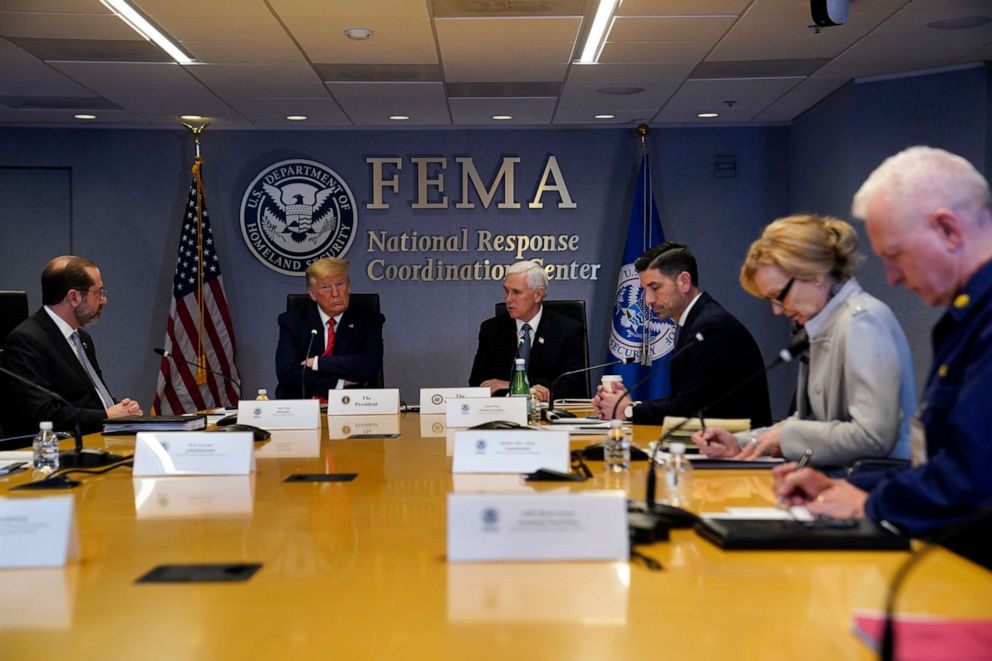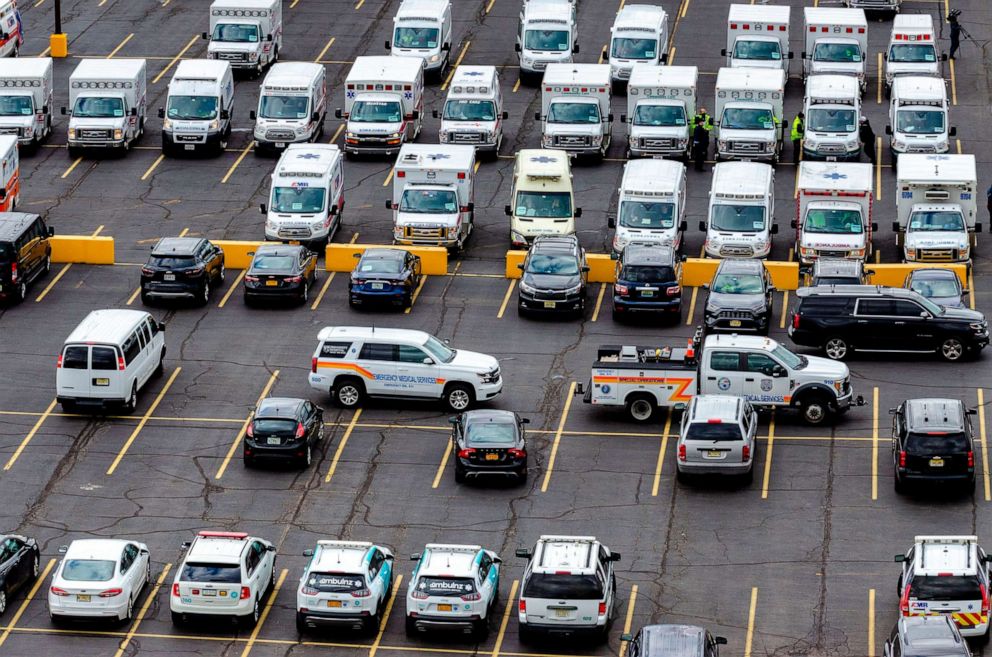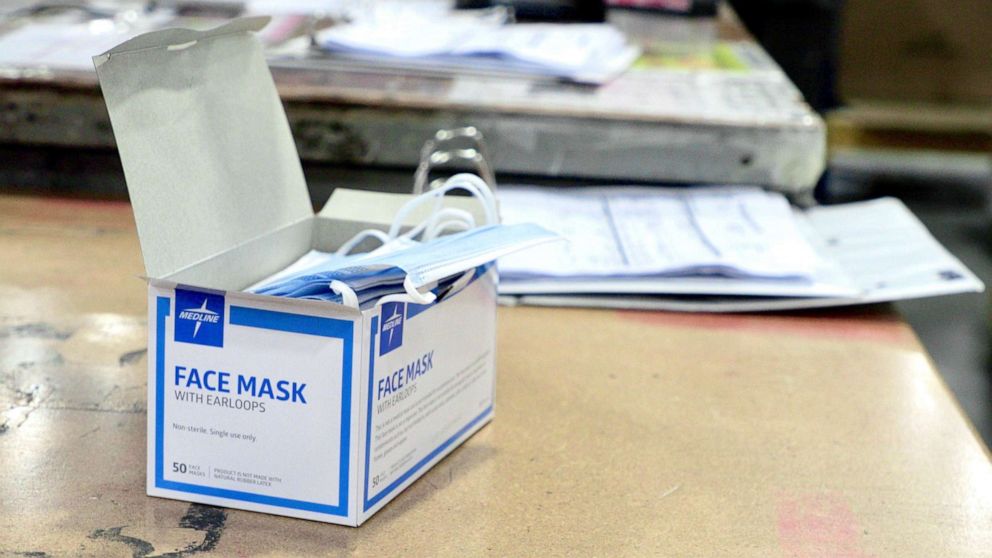FEMA's coronavirus response by the numbers: 33M masks, 56M respirators, 10,000 ventilators
Agency is ramping up efforts, but hospitals still await critical supplies.
Last month as the country struggled to defend itself from the coronavirus, some critics were asking where the Federal Emergency Management Agency was and why is wasn’t working overtime to assist a nation amid the pandemic.
But after being brought late into the government's response and as states continue to sound the alarm, the federal agency says it has raced to catch up to the ever-growing demands and has mobilized quickly to get critical equipment to those who need it.
“While our national response has dramatically improved since FEMA took charge, one has to wonder why the White House waited so long to place them in charge and whether that delay placed lives at risk,” said ABC News contributor John Cohen, a former acting undersecretary at the Department of Homeland Security where he worked with FEMA.
“It is not a surprise to me that things began to improve when FEMA was elevated” to oversee pandemic response, Cohen said. “What is a surprise to me, is that they weren’t activated in January.”

Warnings about a potential pandemic were first transmitted to the White House in early January, but FEMA was not included in President Trump’s coronavirus task force. On March 13, FEMA was activated but remained in a supporting role to the Department of Health and Human Services until the following week.
Then, on March 18, FEMA was designated the “lead federal agency,” enabling it to coordinate with federal and private partners to get supplies, equipment and drugs where they needed to go – as fast as possible.
“FEMA now is fully engaged at the highest levels,” President Trump said at a daily coronavirus briefing.
In the ensuing weeks some state governors and medical professionals have continued to sharply criticize the federal government's response to the pandemic, including what some said is a flawed and counter-productive distribution system for critical equipment.

Recently, FEMA defended its role in the battle against the coronavirus through a host of numbers that it said reflected an intense effort.
According to a 13-page document prepared by FEMA’s press office outlining the agency’s actions to the COVID-10 pandemic and provided to ABC News, FEMA has designated $5.6 billion to the fight, coordinated the delivery of 33 million masks, 56 million N-95 respirators, and over 10,000 ventilators -- many from overseas -- and activated the National Response Coordination Center, or NRCC, the agency’s mission control at headquarters in Washington.
Tune into ABC at 1 p.m. ET and ABC News Live at 4 p.m. ET every weekday for special coverage of the novel coronavirus with the full ABC News team, including the latest news, context and analysis.
In collaboration with the U.S. Army Corps of Engineers, FEMA said it has identified, designed, and overseen or is overseeing the construction of 32 alternate care facilities across the nation, which includes New York’s Javits Center with 2,148 medical beds.
Chicago’s McCormick Place, one of the largest convention centers in the country, is normally used for trade and industry shows. It will now serve as a relief to hospitals if the city starts to reach their capacity by taking on their less severe patients into their 3,000 bed temporary hospital, according to James Joseph, FEMA’s “Region V” federal coordinating officer.
“One of the things we are most proud of is how quickly we are able to meet the need for alternate care sights,” said Joseph.
'They had a lot of things to get caught up on'
Bringing together the huge array of resources spread through the sprawling federal bureaucracy is a capability unique to FEMA, said former agency Administrator Craig Fugate. From the Department of Defense to the Post Service to Agriculture and Treasury, Fugate said, FEMA knows who in the government does what and has the authority to mobilize those resources when that is what’s needed.
“Logistics is really about the ability to identify, source, procure, and deliver,” said Fugate.

While different disasters require different responses, Fugate said, disaster planners use the same skills to procure food, water and tarps in a hurricane as they do in finding masks and gowns during a pandemic.
“FEMA got placed in this after decisions were already made,” Fugate said. “They had a lot of things to get caught up on.”
One of FEMA’s biggest challenges in the pandemic, Fugate said, has been the high demand for PPE, or personal protective equipment. A lack of PPE has become a focus of much of the criticism of the federal government's response to the crisis, as hospitals across the nation have reported shortages that healthcare workers say puts them in grave danger.
FEMA says it has worked to secure PPE from wherever it can find it, both domestically and abroad.
What to know about coronavirus:
- How it started and how to protect yourself: Coronavirus explained
- What to do if you have symptoms: Coronavirus symptoms
- Tracking the spread in the U.S. and worldwide: Coronavirus map
Federal agencies, from the Food and Drug Administration to the Department of Defense have donated PPE that was then distributed by FEMA to locations in need.
Medical supplies have been donated to the federal government from companies including Boeing, Apple and Jockey, and from as far away as Russia and Qatar, according to the FEMA document.
Project Air Bridge's dozens of flights
In FEMA’s Region V, which includes Michigan and Illinois, coordinator Joseph said he received a late night phone call last week from one of the states in his region with an urgent request for PPE. Within 12 hours of receiving the request, Joseph said he was able to tell officials 500,000 N-95 masks were en route.
“What would traditionally take medical distributors 35-40 days by cargo ship, we’re able to expedite that in three to four days by chartering planes for distributors to bring that equipment here,” said Joseph.
The FEMA-chartered flights loaded with PPE are part of Project Air Bridge, a modernized, medical version of the Cold War-era Berlin Airlift, and cited frequently at the daily White House coronavirus task force briefings.

To date, nearly 70 Project Air Bridge flights have landed, transporting 760,000 N-95 respirators, 44 million surgical masks, and 7 million gowns from multiple overseas origins. Another 50 flights are scheduled in the coming month, according to FEMA.
FEMA arranged for a shipment of nearly 6 million surgical masks to land last Wednesday morning at Chicago’s O’Hare airport. The cargo jet had just traveled the 7,000-mile journey from Shanghai, loaded with masks and respiratory equipment owned by the medical supply company Medline.
The masks were forklifted off the belly of the jumbo jet and loaded onto trucks bound of Medline’s distribution warehouse outside Chicago. Approximately half were allocated to FEMA designated hot-spots -- the agency declined to say exactly where -- and the rest sent to Medline customers and infused back into the U.S. supply chain. A Medline spokesman told ABC News there is no cost mark up for customers for the rushed delivery.
From the moment the Project Air Bridge flight landed at O’Hare until the PPE reaches customers in need takes less than a week, according to a Medline spokesman, citing their massive distribution system which relies on a network of warehouses across the country.
“We have 10,000 people working across country in distribution center and manufacturing plants, who continue to come to work every single day because they know what they’re doing is saving lives,” Medline spokesman Jesse Greenberg told ABC News, adding that he thought the truck drivers who deliver the products in that 24 hour time span are the "unsung heroes" of the crisis.
In receiving equipment, some states accuse feds of interfering
FEMA’s distribution efforts have hardly been free of criticism, including claims that the federal government has gone so far as to take away orders of equipment from the states, even after the administration has told states it is their responsibility to try and procure PPE.
New York Gov. Andrew Cuomo has repeatedly criticized the system used to procure PPE, calling it "eBay" with all the states, “and then FEMA gets involved and FEMA starts bidding.”
Massachusetts Gov. Charlie Baker told the president in a video conference on March 19 that he tried to place “three big orders” for PPE, but lost to the federal government.
The governors of Michigan and Maryland, in a March 30 op-ed for the Washington Post, claimed the lack of coordination is creating “a counterproductive competition between states and the federal government.”
Just last week, the American Medical Association wrote a letter to the head of FEMA logistics, asking them to establish a “national system of PPE acquisition” because states and hospitals are currently in “direct competition” with each other as well as the federal government.
Amid reports that the government was actually commandeering some shipments, a FEMA spokesperson said that PPE being distributed within the U.S. is "not being seized or rerouted," and urged hospitals or local officials to report it if they believe it's happened to them.
As for states being outbid, the spokesperson said that "if a company decides to cancel on a state contract in favor of [a] federal one, FEMA will work with the company and the state to resolve the matter in a way that best serves their people."
Dr. Jay Bhatt, a former medical chief of the American Hospital Association, said that while there has been "progress in getting PPE to places that need it most," the crisis has shown the supply chain is "broken."
"It simply has to be easier for hospitals and health systems to get PPE when they need it," said Bhatt, now an ABC News contributor.
For FEMA, the challenges are only expected to grow. Looming on their horizon is severe weather, spring flooding, and hurricane season. Fugate, who was administrator for eight years, said the challenge with COVID-19 is it does not look to be a short term disaster.
James Joseph, whose FEMA region across the Midwest is vulnerable to severe weather especially in the coming months, is already planning in the event they need to respond to major flooding or a tornado. “But," he asked, "what does the delivery model look like in a COVID-19 mitigation environment?”
He summed up his approach: “It’s not a sprint. Not a marathon. It’s a triathlon.”




